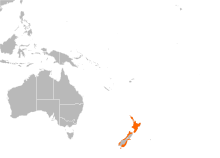Paranephrops zealandicus
| Paranephrops | |
|---|---|
 |
|
| Northern koura, P. planifrons | |
| Scientific classification | |
| Kingdom: | Animalia |
| Phylum: | Arthropoda |
| Subphylum: | Crustacea |
| Class: | Malacostraca |
| Order: | Decapoda |
| Infraorder: | Astacidea |
| Family: | Parastacidae |
| Genus: |
Paranephrops White, 1842 |
| Species | |
|
|
 |
|
Paranephrops is a genus of freshwater crayfish found only in New Zealand. They are known as crayfish in New Zealand English and koura (or kōura) in Māori. (Confusingly, both words are also used to refer to the marine rock lobster.) There are two species: the northern koura, Paranephrops planifrons, found mainly in the North Island, but also in Marlborough, Nelson and the West Coast of the South Island; and the southern koura, Paranephrops zealandicus, found only in the east and south of the South Island, and on Stewart Island/Rakiura. Both species are a traditional food for Māori, and there is a small koura aquaculture industry for the restaurant market.
Northern koura (P. planifrons) reach lengths of about 70 millimetres (2.8 in), whereas southern koura (P. zealandicus) are slightly larger – 80 millimetres (3.1 in) – with relatively shorter antennae. Their first pair of legs (chelipeds) are pincers used for scavenging food and warding off predators or other koura. The chelipeds in P. zealandicus are much hairer at their tips than those of P. planifrons. The four pairs of well-developed walking legs are used for most movement, but the pleopods are small and no use for swimming; when alarmed, koura can flick their tail forwards violently to propel themselves backwards at speed. They can be sexed by looking at their underside: males have a pair of gonads that protrude from the base of the fourth pair of legs, while females have holes at the base of the second pair of legs.
...
Wikipedia
